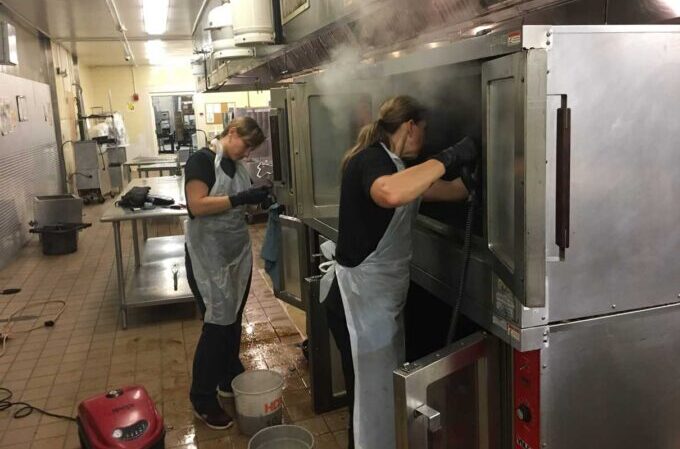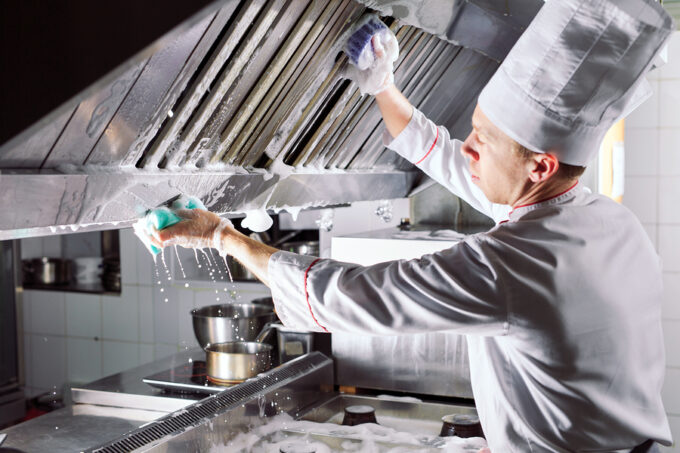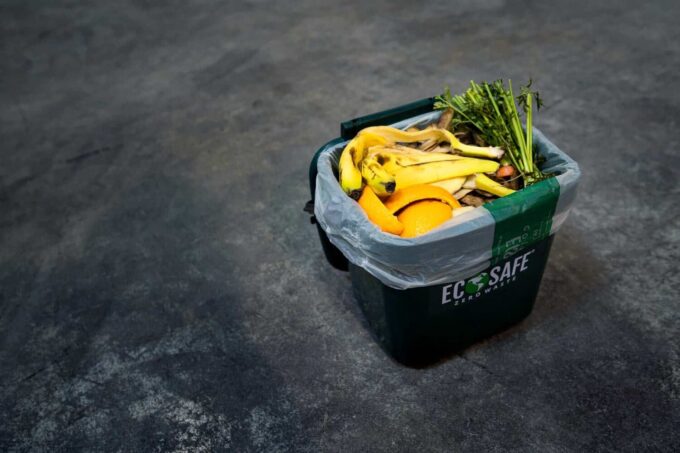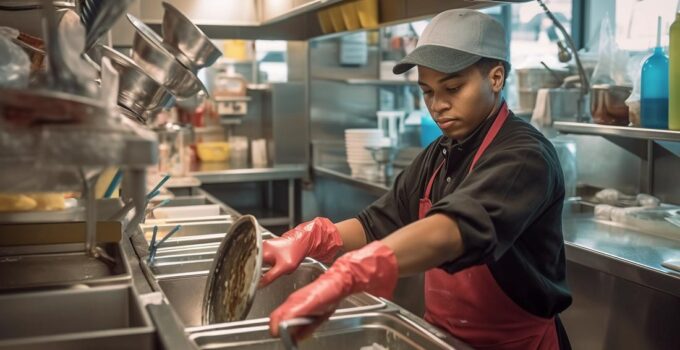In the culinary world, the kitchen stands as a testament to an establishment’s dedication to quality and safety. A commercial kitchen, bustling with activity, is the heart of any restaurant or café.
Ensuring its cleanliness and safety is paramount, not just for health standards but also for delivering an unparalleled dining experience. Dive into these essential tips to ensure your kitchen remains a beacon of hygiene and safety.
Understanding the Basics of Kitchen Hygiene
At the core of every pristine commercial kitchen lies a deep understanding of fundamental hygiene principles. These principles serve as the bedrock upon which all other kitchen practices are built.
- Surface Sanitization: Every surface in a kitchen, from countertops to cutting boards, has the potential to harbor harmful bacteria and pathogens. These microorganisms can easily transfer to food, leading to potential health risks.
- Hand Hygiene: Hands are the most common medium for the transfer of bacteria. Regular and thorough handwashing, especially after handling raw food, touching waste, or using the restroom, is crucial. Using warm water, soap, and scrubbing for at least 20 seconds is recommended.
- Safe Food Handling: Raw foods, especially meats, are often teeming with bacteria. Handling them safely ensures that these bacteria don’t transfer to other foods or surfaces.
- Use of Protective Gear: In a commercial kitchen, protective gear like gloves, hairnets, and aprons aren’t just for the staff’s protection; they also prevent contaminants from reaching the food.
Scheduled Deep Cleaning

Source: steamcleaningvirginia.us
While daily cleaning routines are essential, they often skim the surface. Periodic deep cleaning sessions ensure that every corner, including those often overlooked, is spotless. This involves cleaning under appliances, descaling faucets, and even cleaning out exhaust hoods.
Such sessions, though time-consuming, ensure that grime and grease don’t accumulate, leading to a safer working environment. If you’re unsure whether you can do it on your own, or you simply lack the professionals in your team, you can seek help with Kitchen Commercial Cleaning.
Smart Storage Solutions
A cluttered kitchen is not only challenging to work in but also poses contamination risks. Organizing storage areas ensures easy access and reduces the chances of cross-contamination. For instance, raw meats should be stored separately from vegetables. Using clear containers for dry goods can help in easy identification and ensure that everything is used before its expiration date. Remember, the way you store food can significantly impact its quality and safety.
Investing in Modern Cleaning Technologies
In today’s age, relying solely on manual cleaning might not be enough. Modern cleaning technologies, from ultraviolet sanitizers to high-pressure steam cleaners, can offer a level of cleanliness hard to achieve manually. These tools, though an investment, can save time and ensure that the kitchen remains spotless and germ-free.
Safety and Hygiene Training for Staff

Source: mastercleaners.com.au
The backbone of any successful commercial kitchen is its staff. Their skills, dedication, and practices directly influence the quality of food and the overall safety of the kitchen environment. As such, equipping them with comprehensive safety and hygiene training is paramount. This training not only ensures adherence to health standards but also fosters a culture of excellence and responsibility.
- Importance of Regular Training: In the dynamic environment of a commercial kitchen, periodic training sessions are essential. New staff members need to be oriented with best practices, while seasoned employees benefit from refreshers and updates on new protocols.
- Handwashing Techniques: One of the simplest yet most effective hygiene practices is proper handwashing. Staff should be trained to wash their hands thoroughly using warm water and soap, scrubbing for at least 20 seconds.
- Safe Food Handling and Preparation: Training should cover the correct methods to handle different types of food, emphasizing the prevention of cross-contamination.
- Use of Protective Gear: Staff should be educated on the importance and correct use of protective gear. This includes wearing gloves when handling ready-to-eat foods, using hairnets to prevent hair from falling into dishes, and understanding when and how to replace or clean aprons and other protective clothing.
Routine Equipment Check-ups
Malfunctioning equipment doesn’t just slow down operations; it can be a safety hazard. Regular maintenance checks ensure that everything, from ovens to refrigerators, is in top working condition. This not only prolongs the life of the equipment but also ensures that they operate safely and efficiently.
- Integrated Pest Management
No matter how clean a kitchen is, it can attract pests if not properly safeguarded. Regular inspections, combined with preventive measures like sealing potential entry points and using natural repellents, can keep these unwelcome guests at bay. Remember, proactive measures are always better than reactive ones when it comes to pests.
- Eco-friendly Waste Disposal

Source: ecosafe.green
In today’s environmentally-conscious era, waste disposal in commercial kitchens goes beyond merely getting rid of trash. It’s about adopting sustainable practices that minimize environmental impact while ensuring the kitchen remains clean and efficient.
Eco-friendly waste disposal not only aligns with the global push towards sustainability but also offers tangible benefits to the establishment, from cost savings to enhanced brand image. Here’s a deeper dive into the facets of eco-friendly waste disposal in commercial kitchens:
- Understanding Waste Streams: Before implementing eco-friendly disposal methods, it’s essential to understand the different waste streams generated in a kitchen. Typically, these can be categorized into organic waste (food scraps, peels), recyclables (glass, paper, plastics), and non-recyclables (certain plastics, broken utensils).
- Composting Organic Waste: One of the most effective ways to deal with organic waste is composting. By converting food scraps and other organic materials into compost, kitchens can reduce the amount of waste sent to landfills and produce nutrient-rich compost that can be used for gardening. Some establishments even use this compost in their kitchen gardens, creating a closed-loop system.
- Recycling: Implementing a robust recycling program can significantly reduce the environmental footprint of a kitchen. This involves segregating recyclable materials, like glass, metals, and certain plastics, and ensuring they are sent to appropriate recycling facilities. Staff training is crucial here, as contamination can render recyclables useless.
- Reducing Single-Use Items: A proactive approach to eco-friendly waste disposal is reducing waste generation in the first place. By minimizing the use of single-use items, like plastic straws or disposable cutlery, kitchens can significantly cut down on non-recyclable waste.
Closing Thoughts
A commercial kitchen is more than just a place where food is prepared; it’s a symbol of an establishment’s commitment to quality and safety. By implementing these strategies, establishments can ensure that their kitchen remains a safe and clean environment, ready to churn out culinary masterpieces.
After all, in the world of gastronomy, excellence lies in the details. Cleaning kitchen sinks is important so you can pre-wash dishes undisturbedly. In order to do that, your sink must not be clogged but, if it is, worry not because our article will teach you how to unclog the kitchen sink so you can keep on using it without any problems.







